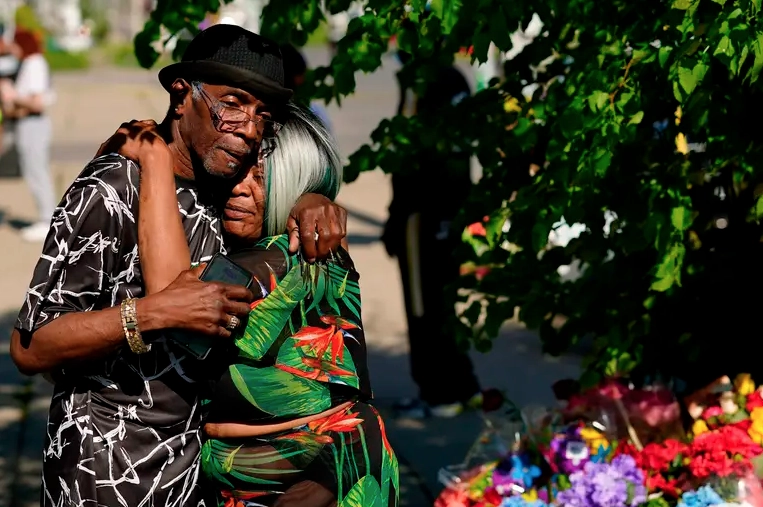Co-author Emmanuel Guerisoli
The recent racist massacre in Buffalo has a global history preceding it. In fact, the terrorist’s 180-page “manifesto” praises Argentina on its first page, for its alleged racial status. The assassin idealizes the South American country through racist and delusional lying and claims that Argentina is the only “white” country with a high birth rate that would defend it from the enemies of the white race. Where does this delusional fantasy of a “white Argentina” come from?
Argentina is a diverse, often open, tolerant, and generous country. And it is also a country that like many has a long history of fascism and various racism.
The “great replacement theory”.
The Buffalo terrorist adheres to the so-called “great replacement theory,” whose origins go back to the ideas of social degeneracy and scientific racism of the late 19th century. According to them, Western civilizational superiority had to be maintained biologically and culturally to avoid chaos and social collapse. This ideology was widely accepted by political elites in several countries on both sides of the Atlantic and gave rise to eugenic, segregationist, anti-immigration, and ultimately fascist and genocidal policies.
In the 1930s, the Nazis radicalized the lie of a Jewish conspiracy to organize race-mixing, leading to the worldwide extermination of white populations. From then on, the idea of “white genocide” was used by fascists and related organizations during the Cold War to justify political violence in the name of the existential defense of ethnic nationalism.
In the 1970s, the Latin American Anti-Communist Confederation introduced notions of “genocide and white supremacy” that influenced the doctrines of the agencies responsible for Operation Condor. The dictatorships of Bolivia, Chile, and Paraguay were very receptive to such ideas due, in part, to the presence of former Nazis and former Ustaša – a Croatian nationalist terrorist organization based on religious racism and allied with Nazism – in high positions.
The Latin American military juntas perceived themselves as warriors of a historical crusade against a global conspiracy and in defense of Western Christian civilization. During the 1970s and 1980s, there was strong transatlantic cooperation between junta operatives, neo-fascist European paramilitary organizations such as P2, the apartheid governments of Rhodesia and South Africa, and elements of the U.S. far-right.
These relationships bore fruit during the wars and genocidal massacres in Central America, in which Argentina was directly involved by sending “advisors” who were experts in illegal repression. This allows us to understand where the delusion of a Latin America with a central role in the defense of the West comes from.
Let us not forget that the Buffalo terrorist also says that this racial struggle could begin in countries such as Argentina or Venezuela and even mentions Uruguay as one of the countries “anchored in the white race”, together with Australia, Argentina, New Zealand, and the United States. Now, why does the terrorist put Argentina in a central place? This emphasis on the Latin American nation can only be understood in terms of shared histories and fascist traditions, transnational racist fantasies. These are the global memories of international fascism. In internet forums, extremists of global neofascism admire the Argentine dictatorship and also Augusto Pinochet as actors to be emulated.
While one of the founders of Argentine fascism, Leopoldo Lugones, defended Argentine imperialism for that “white” superiority over other Latin American nations, the generals of the last military dictatorship (1976-1983), killed tens of thousands of citizens in their “dirty war” launched in the name of the “Christian West”, used similar logic.
In 1976, General Videla stressed the global character of the struggle: “the fight against subversion is not limited to a purely military dimension. It is a worldwide phenomenon. It has political, economic, social, cultural and psychological dimensions”.
Specifically, ideas of replacement and invasion and paranoid fantasies about the expansion and migration of non-white Europeans are central to the Argentine fascist tradition. The infamous statements of General Albano Harguindeguy, Minister of the Interior under the Argentine dictatorship can only be understood from this historical perspective. In 1978, Harguindeguy spoke of the need to encourage European immigration so that Argentina could “remain one of the three whitest countries in the world”.
This explicit racism in Argentina took the form of open recognition of the need to eradicate other “non-European” expressions from the nation. The depth and scope of this desire were manifested, once again, in the concentration camps, which functioned as clandestine centers of detention and torture, in which racism and anti-Semitism had a central place.
The fight against the enemy knew no bounds. International cooperation between fascist and white supremacist organizations continued after the end of the Cold War. If before they fought to defeat communism in Angola, Chile, or Nicaragua, now the enemy was Islam and multiculturalism, which the anti-Semitic delirium considers being financed by Judaism.
The attacks in Utøya, Munich, Pittsburgh, El Paso, Christchurch, and now Buffalo, among others, are the continuation of fascist violence against minorities to whom, in their ideological delirium, they attribute the future destruction of Western civilization and Christian values.
Fascism is and has always been transnational. It is not possible to understand this American history with ideas of exceptionalism because almost nothing is exceptional in American fascist traditions. In any case, it is understandable that much attention has been paid to the local dimensions of the phenomenon, if not so much to American history. But what has been completely ignored so far are the global histories of fascism behind these attacks.
Translated from Spanish by Janaína Ruviaro da Silva













